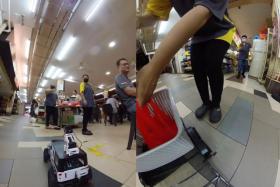Innovators thrive in the 'discomfort zone'
Creating an innovative culture an uphill task in government
In this digital economy, it is fashionable to talk about innovation.
Innovation is hard work.
As organisations jump onto the innovation bandwagon, I'd like to share some lessons on innovation in the public sector, which has often been seen as innately conservative and bureaucratic.
People are enamoured of new technologies.
Leaders will go on a business trip, read a magazine, talk to an "expert", and a new "sexy" technology becomes the obsession of an entire organisation. Everyone is running around trying to find a "problem" for the new technology to solve.
Many new technologies are usually at the "peak of inflated expectations", so distinguishing hype from reality is important.
The public sector is not the private sector, where public accountability is important. For the government to be innovative in deploying new technology, we need to focus on solving compelling problems faced by citizens and businesses.
The sense of purpose and focus motivates innovative people from all quarters to make use of the best available tech and non-tech solutions to solve the problem. When we are clear about the problem we are trying to solve, innovation has a chance of happening.
The discomfort zone pushes innovators to keep challenging boundaries and learn from each attempt.
Leading companies like Amazon and Microsoft start product creation by writing a press release.
This process focuses the company on the impact the product will have on its customers. It focuses on the outcome and addresses the needs of the customers.
The business case, architecture, technologies etc flow naturally from the press release's creation.
Innovative people have a natural curiosity and tenacity. They are not limited by rules or conventionality.
They are constantly thinking of ways to solve problems. In the end, it is all about persistence, patience and perseverance.
For innovation to flourish, we need to design a non-traditional, flat-structure environment that is nurturing and supportive; and to develop a culture that celebrates collaboration, diversity and tolerance.
It is about who can bring the best solution to the table each day. Respect and leadership is not anointed, it must be earned.
HIVE
GovTech's Government Digital Services unit at Hive@Sandcrawler is an example of how we created such a "centre of gravity" to house together the government's creative information and communications technology (ICT) and engineering talent.
Hive is home to creative folks of different specialties and experience - from data scientists to software developers to user experience designers - working collaboratively and consultatively in 'tribes' to design digital products and services for the public sector.
Recently, I watched a documentary called "Ants on a Shrimp" on a plane.
It was about the best restaurant in the world called Noma and the creative genius of its owner Rene Redzepi.
He mentioned that to be creative and innovative, he must always move out of the comfort zone. He thinks that is the essence of innovation.
Thriving in the discomfort zone is tough. It is about being comfortable with uncertainty and the lack of structure. It is about dealing with constant changes and failures.
These days, failing fast is almost synonymous with innovation. However many people have taken it too far to believe that failing is actually good.
Failing fast is very different from bound-to-fail. The sheer number of start-ups that are doomed to fail from day one is not a good example of failing fast.
Every endeavour should have at least a fighting chance of success before you start. The key is to take sensible risks and learn from it. Reckless pursuit is not innovative; it is foolish.
The discomfort zone pushes innovators to keep challenging boundaries and learn from each attempt. It is not the natural instinct of most people - especially in an environment that is risk-averse and that rewards certainty - to want to work in a discomfort zone.
For all these reasons, creating an innovative culture is an uphill task in government.
The most difficult thing about innovation is that many senior managers do not know their role in making innovation happen.
It is hard for senior managers to be the innovator themselves. It is more about placing bets on teams that can make innovation happen. Most managers want some measure of success before standing behind the project.
Sponsoring innovation is a bet. Experience plays a big part, but knowing the problem you want to solve is critical.
Being focused on the problem at hand and not to be easily distracted by "sexy" new technology allows us to separate fluff from substance early on. In this way, real innovation is supported throughout their life cycle.
At the same time, we have to be ruthless in cutting out innovation that does not make sense early on to ensure optimal allocation of precious investment dollars.
The writer is Government Chief Information Officer, Government Technology Agency.
Get The New Paper on your phone with the free TNP app. Download from the Apple App Store or Google Play Store now



